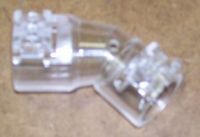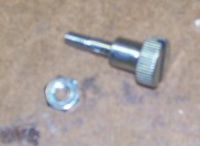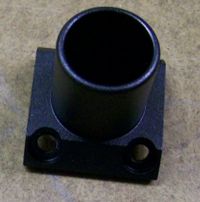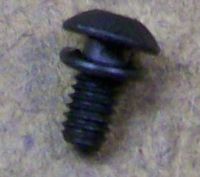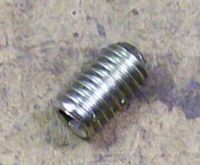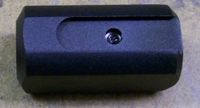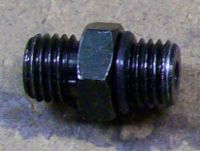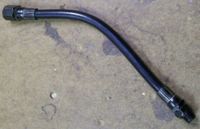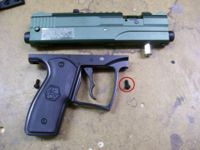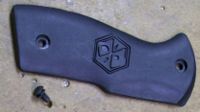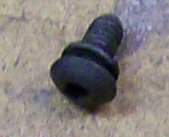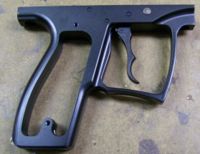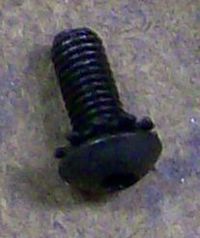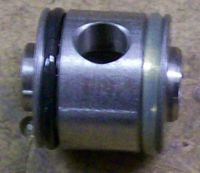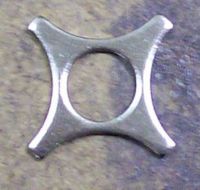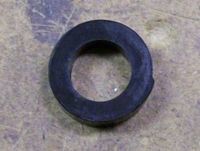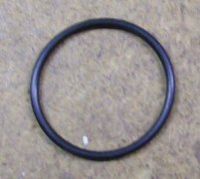Paintball gun
From DDL Wiki
(→Components) |
|||
| Line 32: | Line 32: | ||
|- | |- | ||
! 01 | ! 01 | ||
| - | | Hopper Connection || 1 || Connect hopper and feed neck || 0.7 || Plastic || | + | | Hopper Connection || 1 || Connect hopper and feed neck || 0.7 || Plastic || Injection Molded, finish machiend || [[Image:Paintball_gun_hopper_connect.jpg|200px]] |
|- | |- | ||
! 02 | ! 02 | ||
| - | | Hopper Connection Bolt and Nut || 2 || Apply pressure to plastic hopper connection housing || 0.4 || | + | | Hopper Connection Bolt and Nut || 2 || Apply pressure to plastic hopper connection housing || 0.4 || Steel || Heading and Thread Rolling || [[Image:Paintball_gun_hopper_connect_nutbolt.jpg|200px]] |
|- | |- | ||
! 03 | ! 03 | ||
| - | | Stock || 1 || Helps stabilize gun against shoulder for improved accuracy || 8.7 || | + | | Stock || 1 || Helps stabilize gun against shoulder for improved accuracy || 8.7 || Aluminum || Cast || [[Image:Paintball_gun_stock.jpg|200px]] |
|- | |- | ||
! 04 | ! 04 | ||
| - | | Barrel || 1 || Direct paintball exit out of marker || 4.7 || | + | | Barrel || 1 || Direct paintball exit out of marker || 4.7 || Aluminum || Cast and finish machined || [[Image:Paintball_gun_barrel.jpg|200px]] |
|- | |- | ||
! 05 | ! 05 | ||
| - | | Feed Neck || 1 || Direct paintballs from hopper into firing chamber || 0.6 || | + | | Feed Neck || 1 || Direct paintballs from hopper into firing chamber || 0.6 || Aluminum || Cast and finish machined || [[Image:Paintball_gun_feed_neck.jpg|200px]] |
|- | |- | ||
! 06 | ! 06 | ||
| - | | Feed Neck Screw || 3 || Attach Feed Neck to marker body || 0.1 || | + | | Feed Neck Screw || 3 || Attach Feed Neck to marker body || 0.1 || Steel ||Heading and Thread Rolling || [[Image:Paintball_gun_feed_neck_screw.jpg|200px]] |
|- | |- | ||
! 07 | ! 07 | ||
| - | | MR1 2" Dovetail Drop Forward || 1 || Bracket to secure compressed air connection port to trigger handle || 1.2 || | + | | MR1 2" Dovetail Drop Forward || 1 || Bracket to secure compressed air connection port to trigger handle || 1.2 || Steel || Cast or Forged || [[Image:Paintball_gun_dovetail.jpg|200px]] |
|- | |- | ||
! 08 | ! 08 | ||
| - | | Drop Forward Lock Screw || 1 || Secures Dovetail Bottom-Line to Dovetail Drop Forward || <0.1 || | + | | Drop Forward Lock Screw || 1 || Secures Dovetail Bottom-Line to Dovetail Drop Forward || <0.1 || Steel || Forging and Thread Rolling || [[Image:Paintball_gun_dovetail_lockscrew.jpg|200px]] |
|- | |- | ||
! 09 | ! 09 | ||
| - | | MR1 Dovetail Bottom-Line || 1 || Connection point between compressed air and hose to marker body || 3.2 || | + | | MR1 Dovetail Bottom-Line || 1 || Connection point between compressed air and hose to marker body || 3.2 || Aluminum || Cast and finish machined || [[Image:Paintball_gun_dovetail_bottom.jpg|200px]] |
|- | |- | ||
! 10 | ! 10 | ||
| - | | Hose Adaptor || 1 || Connect hose to Dovetail Bottom-Line || 0.4 || | + | | Hose Adaptor || 1 || Connect hose to Dovetail Bottom-Line || 0.4 || Steel || Forged and Threads rolled || [[Image:Paintball_gun_dovetail_hose_adapt.jpg|200px]] |
|- | |- | ||
! 11 | ! 11 | ||
| - | | MR1 Foregrip || 1 || Provides cover for hose connection to marker body. || 4.9 || | + | | MR1 Foregrip || 1 || Provides cover for hose connection to marker body. || 4.9 || Aluminum || Extruded or Cast and finish machined || [[Image:Paintball_gun_foregrip.jpg|200px]] |
|- | |- | ||
! 12 | ! 12 | ||
| - | | Foregrip Fixing Screw w/washer || 2 || Connect foregrip to marker body || 0.4 || | + | | Foregrip Fixing Screw w/washer || 2 || Connect foregrip to marker body || 0.4 || Steel || Heading and Thread Rolling || [[Image:Paintball_gun_foregrip_screw.jpg|200px]] |
|- | |- | ||
! 13 | ! 13 | ||
| - | | Braided Hose || 1 || Connects Dovetail Bottom-Line to marker body || 1.8 || | + | | Braided Hose || 1 || Connects Dovetail Bottom-Line to marker body || 1.8 || Steel || Connections Headed and Threads Rolled, hose housing woven from metal sheet || [[Image:Paintball_gun_hose.jpg|200px]] |
|- | |- | ||
! 14 | ! 14 | ||
| - | | Screw and Washer || 2 || Connects trigger handle to marker body || 0.1 || | + | | Screw and Washer || 2 || Connects trigger handle to marker body || 0.1 || Steel || Heading and Thread Rolling || [[Image:Paintball_gun_handle_screw.jpg|200px]] |
|- | |- | ||
! 15 | ! 15 | ||
| - | | Handle Covers || 2 || Provides comfortable grip for handle || 0.8 || | + | | Handle Covers || 2 || Provides comfortable grip for handle || 0.8 || Aluminum || Cast and finish machined || [[Image:Paintball_gun_handle_cover.jpg|200px]] |
|- | |- | ||
! 16 | ! 16 | ||
| - | | Screw || 4 || Connects handle cover to handle || 0.1 || | + | | Screw || 4 || Connects handle cover to handle || 0.1 || Steel || Heading and Thread Rolling || [[Image:Paintball_gun_handle_cover_screw.jpg|200px]] |
|- | |- | ||
! 17 | ! 17 | ||
| - | | Handle Trigger Assembly || 1 || Allows user to control firing of paintball. Double trigger controls release of bolt, firing paintball || 9.4 || | + | | Handle Trigger Assembly || 1 || Allows user to control firing of paintball. Double trigger controls release of bolt, firing paintball || 9.4 || Steel || Cast, Finish machined, finish ground, press fitting || [[Image:Paintball_gun_handle.jpg|200px]] |
|- | |- | ||
! 18 | ! 18 | ||
| - | | MR1 Reservoir Plug || 1 || Seals compressed air resevoir and includes attachment point for valve spring || 0.8 || | + | | MR1 Reservoir Plug || 1 || Seals compressed air resevoir and includes attachment point for valve spring || 0.8 || Aluminum|| CNC Turned || [[Image:Paintball_gun_res_plug.jpg|200px]] |
|- | |- | ||
! 19 | ! 19 | ||
| - | | M5x12 Screw || 1 || Attaches Reservoir Plug to marker body || 0.1 || | + | | M5x12 Screw || 1 || Attaches Reservoir Plug to marker body || 0.1 || Steel || Heading and Thread Rolling || [[Image:Paintball_gun_res_plug_screw.jpg|200px]] |
|- | |- | ||
! 20 | ! 20 | ||
| - | | Valve Spring || 1 || Provides pressure against cup seal to press valve pin into valve body || 0.1 || | + | | Valve Spring || 1 || Provides pressure against cup seal to press valve pin into valve body || 0.1 || 5160 Steel || Coiled || [[Image:Paintball_gun_valve_spring.jpg|200px]] |
|- | |- | ||
! 21 | ! 21 | ||
| - | | Cup Seal and Valve Pin Assembly || 1 || Seals hole in valve body so air does not leak out of air reservoir || 0.2 || | + | | Cup Seal and Valve Pin Assembly || 1 || Seals hole in valve body so air does not leak out of air reservoir || 0.2 || Aluminum and Plastic (Nylon) || Finish machined and ground, Injection molded || [[Image:Paintball_gun_valve_assem.jpg|200px]] |
|- | |- | ||
! 22 | ! 22 | ||
| - | | Valve Body || 1 || Routes air to Striker chamber and also to MR1 Venturi Bolt. || 0.2 || | + | | Valve Body || 1 || Routes air to Striker chamber and also to MR1 Venturi Bolt. || 0.2 || Aluminum || Turned and Drilled || [[Image:Paintball_gun_valve_body.jpg|200px]] |
|- | |- | ||
! 23 | ! 23 | ||
| - | | MR1 Venturi Bolt || 1 || Directs air from valve body to paintball. Also stops additional paintballs from entering chamber when firing. || <0.1 || | + | | MR1 Venturi Bolt || 1 || Directs air from valve body to paintball. Also stops additional paintballs from entering chamber when firing. || <0.1 || Steel || Ground and Turned || [[Image:Paintball_gun_vent_bolt.jpg|200px]] |
|- | |- | ||
! 24 | ! 24 | ||
| - | | Cup Seal Guide || 1 || Centers Cup Seal and Valve Pin Assembly in air reservoir || 0.1 || | + | | Cup Seal Guide || 1 || Centers Cup Seal and Valve Pin Assembly in air reservoir || 0.1 || Aluminum || Stamped || [[Image:Paintball_gun_valve_cup_guide.jpg|200px]] |
|- | |- | ||
! 25 | ! 25 | ||
| - | | Striker Spring || 1 || Applies force to Striker Bolt, accelerating it into the valve pin || 0.1 || | + | | Striker Spring || 1 || Applies force to Striker Bolt, accelerating it into the valve pin || 0.1 || 5160 Steel || Coiled || [[Image:Paintball_gun_striker_spring.jpg|200px]] |
|- | |- | ||
! 26 | ! 26 | ||
| - | | Striker Plug || 1 || Seals Striker chamber. Also includes a spring guide for the Striker Spring || 0.8 || | + | | Striker Plug || 1 || Seals Striker chamber. Also includes a spring guide for the Striker Spring || 0.8 || Aluminum || Turned and ground || [[Image:Paintball_gun_striker_plug.jpg|200px]] |
|- | |- | ||
! 27 | ! 27 | ||
| - | | Striker Buffer || 1 || Helps protect Striker Plug and Striker bolt from damage during use from impact || <0.1 || | + | | Striker Buffer || 1 || Helps protect Striker Plug and Striker bolt from damage during use from impact || <0.1 || Aluminum || Turned || [[Image:Paintball_gun_striker_buffer.jpg|200px]] |
|- | |- | ||
! 28 | ! 28 | ||
| - | | Striker Bolt || 1 || Strikes Valve Pin, releasing air from air reservoir, through valve body and MR1 Venturi bolt. Striker Bolt releases when trigger is pulled. || 2.4 || | + | | Striker Bolt || 1 || Strikes Valve Pin, releasing air from air reservoir, through valve body and MR1 Venturi bolt. Striker Bolt releases when trigger is pulled. || 2.4 || Hardened Steel || Turned || [[Image:Paintball_gun_striker_bolt.jpg|200px]] |
|- | |- | ||
! 29 | ! 29 | ||
| - | | Quck Disconnect Pin || 1 || Secures Striker Plug to marker body || 0.3 || | + | | Quck Disconnect Pin || 1 || Secures Striker Plug to marker body || 0.3 || Steel || Cast || [[Image:Paintball_gun_disc_pin.jpg|200px]] |
|- | |- | ||
! 30 | ! 30 | ||
Revision as of 23:06, 23 September 2007
Contents |
Executive Summary
Customer Needs
Most paintball players use their guns in tournament play at parks designed specifically for this purpose. On occasion, teams may play in uncharted forests or abandoned buildings to provide a new thrill and lower playing costs. The object of most games is to successfully shoot a paintball (the projectile) at an opposing team’s player to mark them with the paint inside the projectile. Speeds can reach up to 300 feet per second, over which the sport or play can become unsafe. Certain arenas measure and limit the users’ guns to a lower value. The first and foremost requirement is reliability and durability from a gun. There is nothing more frustrating than a gun malfunction in the middle of a game, when the user travels a significant distance to play. This quality can easily be found due to the strong correlation between price and durability. Having a good line of sight is paramount for aiming. Certain hopper and feeder designs go straight up from the gun housing, making it difficult to look at one’s target. For this reason, most designs incorporate an elbow feeder to offset the hopper towards the user. Barrel lengths will vary from 3 to 48 inches, and are usually interchangeable for a given gun. However studies have shown that no increased accuracy can be gained from a barrel longer than 8 inches. Lightness is a requirement for all levels of play, but again it is merely a question of price. Certain parts can be high strength plastics, sometimes even carbon, which would otherwise be of common metal alloys. The compressed air tank is perhaps one of the heaviest single parts on the marker. Carbon fiber is a popular alternative material for a tank, which may need to stand up to pressures of 5 ksi. More advanced users want quick adjustability of their projectile speeds. Bottom end markers require some tooling to change this setting, but more advanced markers, or aftermarket parts allow for on-the-fly adjustability even in the field. Typical low end markers use compressed CO2 (carbon dioxide), but this may cause inconsistent muzzle velocities. Advanced users will sometimes switched to compressed nitrogen, which eliminates this problem.
How System Functions
The paintball gun (or paintball marker) fires a 0.68 inch diameter paintball at speeds of around 280 fps using compressed air in a semi-automatic firing style. This means that after cocking the marker once, when you pull the trigger it will fire a paintball and also recock the marker for you. This allows the user to rapidly fire paintballs.
Before you can fire the gun, the bolt must be in the cocked position. This is accomplished by pulling the cocking pin back until you hear a click. This is only done once at the beginning of use. When the bolt is pulled back, the Venturi Bolt slides back in the marker barrel (shown in red) which allows a paintball to fall through the feed neck and into the marker barrel. The cocking pin is also connected to the striker bolt, which slides back in the striker chamber (shown in yellow) engaging the trigger mechanism (the trigger mechanism will be described separately in the next section). When the striker bolt engages the trigger mechanism, it is locked in the back position. This causes the striker spring to apply a force to the back of the striker bolt.
In this cocked position, the air reservoir (shown in blue) is filled with compressed air. This chamber is sealed off from the rest of the gun by the cup seal and valve pin assembly. This assembly is being pressed against the valve body (shown in green) by the valve spring. The valve body has three holes, one into the the air reservoir, another into the striker chamber, and a final leading up into the marker barrel. The valve pin extends through the valve body and into the striker chamber.
When the trigger is pulled, the striker spring pushes the striker bolt forward. The striker bolt strikes the valve pin, which opens the seal the valve pin and cap seal were creating with the valve body. Since the striker bolt and venturi bolt are connected, the venturi bolt also moves forward. Before the venturi bolt reaches the front position, it comes in contact with the paintball and pushes the paintball forward toward the barrel. Since the seal in the air reservior was opened, compressed air flows through the valve body into the striker chamber and the marker barrel. The compressed air that flows into the marker barrel accelerates the paintball out of the barrel, firing the paintball marker. The air entering the striker chamber forces the striker bolt back into the cocked position. At this point the valve spring pushes the cap seal and valve pin back against the valve body, sealing the air resevior again. With everything returned to the cocked position, another paintball falls into the marker barrel and the gun is ready to be fired again. The whole process from trigger pull until the gun cocks itself again occurs in less than a second.
Trigger Mechanism Function
Components
**Note: Some assemblies and parts were not disassembled in order to avoid destroying the parts.
DFMA
FMEA
DFE
Opportunities for Improvement
How Product is Used
Markers must be stored in an ‘un-cocked’ position, with the safety switch in the ON position, no compressed air connected to the system, and with the barrel safety plug pressed into the end of the barrel. Most manufacturers require that moving parts be lubricated with the provided or recommended lubricants before each use. Caring users will disassemble several parts of their guns internals, to go through the lubricating steps. This will ensure longevity of the marker. Next, the user will check to have proper pressure in their gas canister, and an abundance of ammunition for the upcoming usage session. When users arrive to the arena, or playing area, overalls or certain special outer wear is put on by the users to attenuate the impact of the projectiles. A mask is the most important piece of protective equipment, guarding the eyes, face and sometimes ears from impact. Welt and ‘black and blue’ spots are common marks caused by being hit with a projectile. Most right handed users will hold the handle with their right hand, use their middle and/or index fingers to operate the trigger, and look down the length of the barrel with their right eye, with the left eye closed. While operating the markers, and trying to mark opponents without being marked themselves, users may perform intense physical activity such as running, jumping, diving and crawling. Some of this may include dirt, when done in an open forest-like area. This aspect of the product usage requires the most out of the marker. The marker must be durable enough to not get damaged, while having a constant supply of air and paintballs to fire in any orientation.

